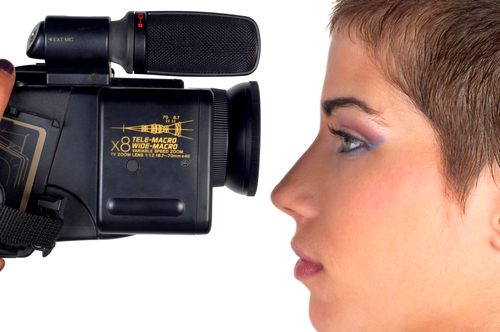
Special Topic: Self-Modeling as “Video Exceptions”
John J. Murphy, Ph.D.
Self-modeling represents a unique application of the solution-focused concept of utilizing “exceptions to the problem.” This section provides an overview of self-modeling and its many and varied applications.
People who receive counseling or psychological services are often characterized by their deficiencies and limitations with little attention to their unique strengths and capabilities. Psychologists and other helping professionals have recently begun to acknowledge the benefits of including the client’s strengths and resources in programs designed to improve behavior. One example of this is the solution-focused strategy of building on exceptions to the problem, which refer to instances during which a person behaves productively and the problem is absent or less noticeable (de Shazer, 1985). These exceptions serve as powerful building blocks for increasing positive behavior.
Video self-modeling represents one of the most innovative and compelling uses of exceptions to the problem (Murphy & Davis, 2005). In self-modeling, an individual learns productive behavior by observing himself or herself engaged in positive behavior from pre-recorded and pre-edited videotapes. With an emphasis on successful behavior (i.e., exceptions), video self-modeling represents a unique and welcome departure from the more common and demoralizing emphasis on problems and deficiencies. Allowing people to watch themselves engaging in productive, functional behaviors is an empowering and respectful way to help them improve their lives and opportunities.
Self-modeling is based on the established principle of modeling, which states that people are more likely to perform a desired target behavior if they have previously observed someone else performing that behavior. This effect is most powerful when the observer and model share similar characteristics. Self-modeling makes optimal use of this learning principle by employing the most powerful model of all -- oneself.
Video self-modeling involves the use of carefully planned and edited positive self-images of adaptive behavior to change the frequency or quality of a person’s behavior. Creative planning and editing result in the production of a short video that people can view as a stand-alone intervention or as part of a multi-component intervention.
Two Types of Video Self-Modeling
There are two types of video self-modeling used to promote behavioral change: feed-forward and positive self-review.
Feed-forward. Perhaps the most dramatic form of self-modeling, feed-forward uses video images of a complex adaptive behavior that has not yet been achieved by the client. The “total behavior image” is created by editing together videotaped sub-components of the complex behavior that have already been performed by the client to create a seamless display of the total behavior sequence. For example, a developmentally disabled teenager might be identified as at-risk for personal safety in public places. Although she hasn’t mastered what to do when a stranger approaches, she can discriminate strangers from friends, say a firm “no thank you,” and make polite small talk. These sub-components can be videotaped separately and edited together into a complete and novel image of the entire behavioral sequence. This technique allows people to watch themselves performing complex age-appropriate behaviors that they have never actually performed in total.
Positive Self-Review. Positive self-review, the most common form of self-modeling, is used to strengthen a new skill or to increase the consistency of an existing skill. An individual is videotaped performing the same skill several times, and a self-modeling tape is created by selecting only the best performances for the person to view.
Applications of Video Self-Modeling
Video self-modeling can be used to enhance or improve existing skills, or to teach new skills in a wide variety of situations. A large body of research has consistently demonstrated that video self-modeling is an effective means of changing a wide range of behavior including the following:
· safety rules and cooperative behaviors
· conversational speech skills for children with autism
· social interaction skills for preschool children
· self-monitoring techniques for overweight adults
· parenting skills for parents of children with developmental disabilities
· disruptive behavior of adolescents diagnosed with behavior disorders
· self-help skills for teenagers with autism
· skills for facilitating positive social interactions between siblings for parents
· skills for parents to assist children with disabilities in performing self-care tasks
As the availability of user-friendly video equipment increases, self-modeling may become a more popular and widespread intervention for a variety of behavioral challenges.
References
Creer, T. L., & Miklich (1970). The application of a self-modeling procedure to modify inappropriate behavior: A preliminary report. Behavior Research and Therapy, 8, 91-92.
de Shazer, S. Keys to solution in brief therapy. New York: W. W. Norton.
Dowrick P. W. & Hood, M. (1981). Comparison of self-modeling and small cash incentives in a sheltered workshop. Journal of Applied Psychology, 66, 349-397.
Dowrick, P. W., & Raeburn, J. M. (1977). Video editing and medication to produce a therapeutic self-model. Journal of Consulting and Clinical Psychology, 45, 1156-1158.
Morgan, R. L., & Salzberg, C. L. (1992). Effects of video-assisted training on employment-related social skill of adults with severe mental retardation. Journal of Applied Behavior Analysis, 25, 365-383.
Murphy, J. J. (2008). Solution-focused counseling in schools (2nd ed.). Alexandria, VA; American Counseling Association.
Murphy, J. J., & Davis, M. W. (2005). Video exceptions: An empirical case study of self-modeling with a developmentally disabled child. Journal of Systemic Therapies, 24, 66-79.
Murphy, J. J., & Duncan, B. L. (2007). Brief intervention for school problems (2nd ed.). New York: Guilford.